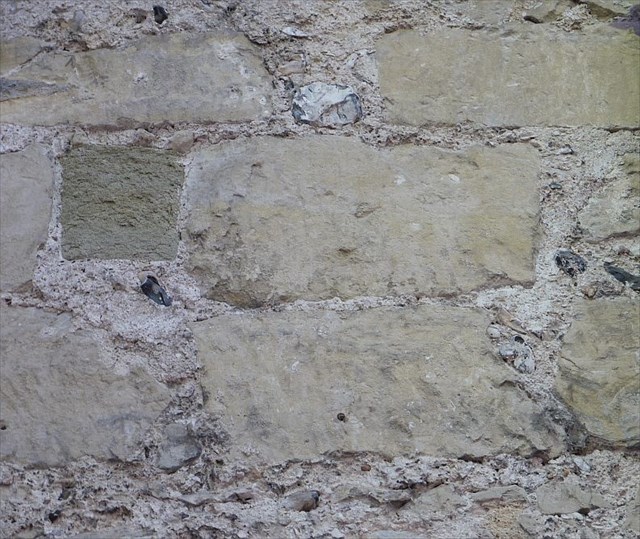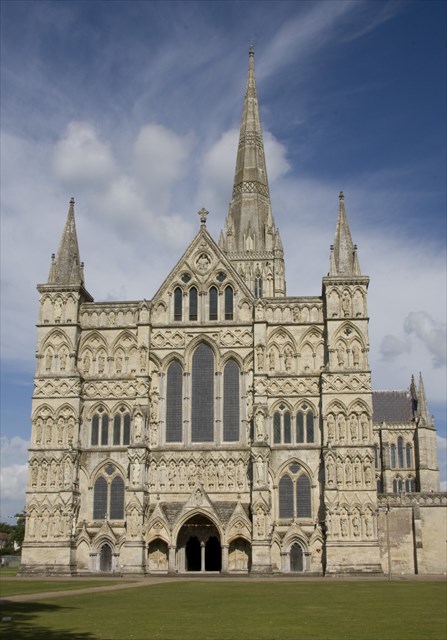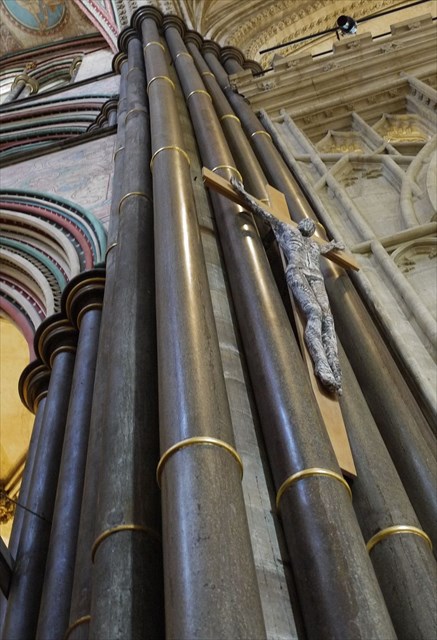The Salisbury Cathedral - A Geological Point of View
This earthcache brings you to the famous Salisbury Cathedral and shows you the cathedral from a more geological perspective. Before moving to the geological aspects some general information at the beginning:
The Salisbury Cathedral, formally known as the Cathedral Church of the Blessed Virgin Mary, is an Anglican cathedral and is considered one of the leading examples of Early English architecture. The main body was completed in only 38 years, from 1220 to 1258 (The foundation stone was laid on 28 April 1220).
The cathedral has the tallest church spire in the United Kingdom (123m/404 ft). Furthermore it has the largest cloister and the largest cathedral close in Britain (80 acres (320,000 m2)). The cathedral contains the world's oldest working clock (from AD 1386) and has the best surviving of the four original copies of the Magna Carta (all four original copies are in England). Although commonly known as Salisbury Cathedral, the official name is the Cathedral of Saint Mary.
Please consider the following opening times when you would like to visit the cathedral and do the earthcache:
| Monday - Saturday |
09:00 - 17:00 |
| Sunday |
12:00 - 16:00 |

The cathedral from outside (click for enlargement)
When work began in 1219 on the cathedral people started to reuse some of the already available stones. Those were some of the Caen stone, the preferred building stone from the Normans in England, from Old Sarum as well as Hurdcott green sandstone with its giveaway specks of glauconite, the dark green silicate mineral that gives it its greenish-grey color. The Hurdcott stone may be seen today in the wall of the Refectory Restaurant that was originally the back wall of the cloisters along with some flint and brick. It was also often used for the upper part of the foundations.

Hurdcott stone in wall of refectory restaurant (click for enlargement)
Looking at the cathedral as a whole you can say that it is constructed almost wholly of Chilmark Stone, variously a calcareous sandstone or sandy limestone. An estimated 60,000 tons of stone was used, mostly in the period 1220-1260. For the completion of the tower and spire 6,500 tons of Chilmark Stone were added even further. The highest 49m of the spire were clad in 200mm thick stone slabs but in the 1950 rebuild the top 9m of Chilmark were replaced by Clipsham stone from Rutland.
The most commonly quarried beds of Chilmark Stone are from the lower part of the Upper Jurassic, Portland Stone Formation. The quarried stone comprises a 10-25 meter sequence of almost horizontal beds of interbedded yellowish grey, glauconitic, carbonate-cemented, bioclastic sandstones and sandy bioclastic limestones. The low regional dip of the strata was undoubtedly an important factor in the easy exploitation of the stone in its early quarrying phase. The individual beds rarely reach more than a meter in thickness, but show a lateral consistency over much of the area.
Chilmark Stone ranges from a very fine- to fine-grained, siliciclastic sandstone to a sandy limestone. Thin sections show that quartz with minor feldpar grains, together with bioclastic debris, make up the main framework constituents. Sparry carbonate cement binds these framework grains together to make a moderately hard stone which is readily sawn into ashlar blocks or carved into elaborate mouldings.
Generally, Chilmark Stone is an excellent building stone. Easily worked, it weathers to an attractive yellowish grey and it has stood the test of time remarkably well. However, even the best building stone has a limited life and after some 700 years of weathering, compounded by the effects of modern atmospheric pollution, parts of the fabric of Salisbury Cathedral are showing signs of decay and are in need of constant attention.

West front with Chilmark Stone (click for enlargement)
Beside Chilmark Stone Purbeck Marble is the other main stone used for the construction of the cathedral. Purbeck Marble is a fossiliferous limestone found in the Isle of Purbeck, a peninsula in south-east Dorset, England.
Purbeck Marble was e.g. used as flooring at Salisbury Cathedral where some 15,000 tons were laid down. Particularly where polished, fossils of the Unio, may be clearly seen, both in the slender columnar lengths or in the flooring.

Fossils of the genus Unio in Purbeck Marble flooring (click for enlargement)
With the addition of the tower and spire huge additional pressure was brought to bear on the existing columns. You can discover evidence of the sinking of the Purbeck limestone at the Crossing, particularly at the North-West corner where five sections of the slender decorative "marble" lengths appear to bend out at the top although they are not, in themselves, bearing any weight. Please note that the limestone that was destined to become the polished Purbeck Marble columnar lengths was quarried from beds horizontally in order to achieve this. Btw: the likely largest slab of Purbeck Marble in the world is to be found in the Morning Chapel and is laid into the floor as a monument to Bishop Wyeville who became bishop at about the same time as the spire was completed.

Purbeck Marble columns (click for enlargement)
To log this earthcache, perform the following tasks and answer the questions via email (you do not need to wait for a log permission. I will contact and help you in the case one of your answers is wrong.):
- The listing says that the Purbeck Marble columns at the Crossing appear to bend. Compare this observation with the whole tower itself. What do you see? Try to measure the effect you are seeing. What does this tell you about the underground of the cathedral?
- Go the Morning Chapel and have a look at the monument to Bishop Wyeville. What is approximately the dimension of the largest slab of Purbeck Marble in the world?
- Optional: take a photo of you or your GPS in front of the Salisbury Cathedral.
Sources: Wikipedia; Website about the Salisbury Cathedral ; Salisbury Cathedral: Matching historic building stone; Journal of the Bath Geological Society, No. 31, 2012: The cathedral rocks – the earth materials used in the construction of Salisbury Cathedral ; The geology of the country around Salisbury
